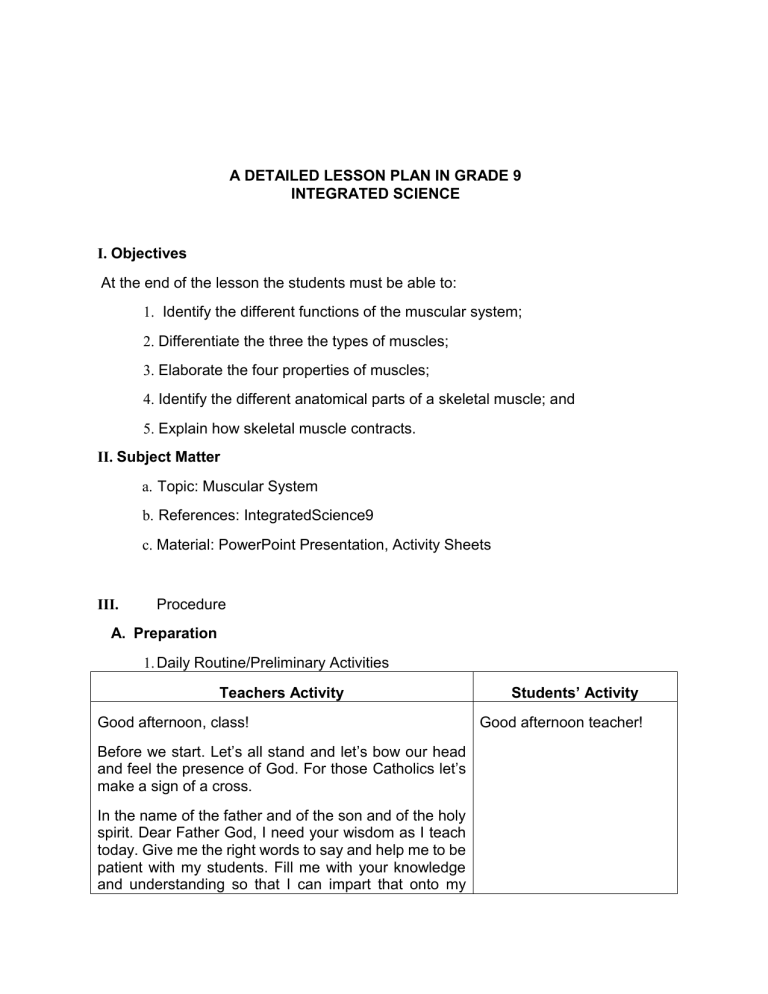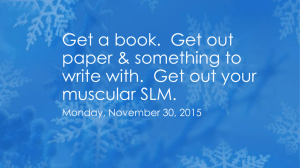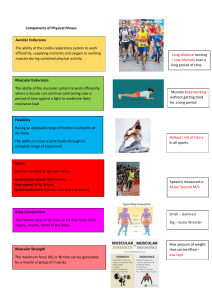
A DETAILED LESSON PLAN IN GRADE 9 INTEGRATED SCIENCE I. Objectives At the end of the lesson the students must be able to: 1. Identify the different functions of the muscular system; 2. Differentiate the three the types of muscles; 3. Elaborate the four properties of muscles; 4. Identify the different anatomical parts of a skeletal muscle; and 5. Explain how skeletal muscle contracts. II. Subject Matter a. Topic: Muscular System b. References: IntegratedScience9 c. Material: PowerPoint Presentation, Activity Sheets III. Procedure A. Preparation 1. Daily Routine/Preliminary Activities Teachers Activity Good afternoon, class! Before we start. Let’s all stand and let’s bow our head and feel the presence of God. For those Catholics let’s make a sign of a cross. In the name of the father and of the son and of the holy spirit. Dear Father God, I need your wisdom as I teach today. Give me the right words to say and help me to be patient with my students. Fill me with your knowledge and understanding so that I can impart that onto my Students’ Activity Good afternoon teacher! students. Help me to remain flexible and open-minded as we learn together. And most of all, guide us oh LORD as we discover more about the world around us. In Jesus’ name, Amen. (Sign of the cross) Good afternoon once again, before we start, let me check your attendance first. Kindly say “myosin” if you’re present. If your classmate is absent kindly say “actin”. Okay, teacher. So today is January 30, 2023. Okay let’s start (Start calling names in the attendance sheet) (Students saying “myosin” teacher) So, how are you today, class? Okay, that’s good to hear that you are all doing great. We are good, teacher. Okay, I can see that you are excited to learn and listen for our discussion today. B. Developmental Activity Can anyone give me a short recap for the discussion (Students last meeting? Kindly raise your hand if you want to hands) share. raising their Yes Ms/Mr… what’s your name? (check the students’ Last meeting we discussed about The Skeletal name on the attendance sheet) System…… Wow! That’s a very comprehensive one. Thank you Mr/Ms….for sharing Is there anyone who wants to share what he/he have (Students raising hands) learned? Yes Ms/Mr… what’s your name? (check the students’ Based on the discussion last name on the attendance sheet) meeting, I’ve also learned that the Skeletal is …….. Okay, thank you for that Ms/Mr…. I can see that you really listened and learned something from the discussion last meeting. Thank you class for sharing your thought about what you’ve learned last meeting. C. MOTIVATION So now class let’s play a game called Copy Face and Body Pose Challenge! okay, so everyone should participate for this challenge. So now here’s how it works. There are 2 I will present in every slide, and each picture will tell you what body pose and face you have to make, is that clear? Yes teacher We do it on the count of 3 and after that you have to freeze for 10 seconds. Now the first person to crack a smile, laugh, blink or break a face, lose. After doing the first round you have do the other body poses and facial expressions for the second round and so on. Is that all clear to you my dear students? Okay, thank you everyone for participating actively in our game for today! Did you enjoy, class? ( the students are having fun doing the activity) Okay so glad to hear that you enjoy our game challenge for this afternoon. D. PRESENTATION OF THE LESSON As you observed we did some movement in our faces and body just to copy those postures and facial expressions. What do you think or what particular system that is responsible for that movement? Skeletal System, ma’am Yes, Aside from Skeletal system? (If no student could answer, go with the plan B) Okay, class. What other system that is responsible for our body movement? Choose an option is it Integumentary system or Muscular System? Yes, very good! Ms/Mr… So now I think you already had an idea about our topic for today. Am I Right? Okay so our topic for today is about muscular system. Ears on me because I will ask questions in between our discussion. Let’s Get started!! Muscular System Ma’am E. DISCUSSION Let’s start with the word Muscles. So what is muscles? Anyone in the class? (Students question) Muscles comes from the Latin “musculus,” literally meaning “little mouse.” So-called because the shape and movement of some muscles (notably biceps) were thought to resemble mice. answers the Muscular System is set of anatomical structures composed of muscle cells, contractile elements and associated connective tissues, that collectively are ( students are listening responsible for the vertebrate body movements. Our attentively in the discussion) body is composed of about 650 muscles and this muscles make up 30-40% of our body weight. These muscles are important for our daily functions that are essential to life. So, on this module we're going to discuss about 4 things the functions of muscular system, the types of muscles, anatomy of skeletal muscles, muscle contraction And of course we're gonna have a short quiz after we finished discussing all the lessons. All right let's begin with the functions of the muscular system. Now producing movement is a common function of all muscle types. Movement or mobility is produced when our muscles contract together. Muscle contraction is like the tightening, shortening, or lengthening of muscles when we do some activity. It can happen when we hold or pick up something, or when we stretch or exercise with weights. like What we’ve seen here on the screen. And this is of course an example of movements. So we have here 3 movements: the gross, fine, and reflexive movement. Muscle contraction contributes both for our gross and fine movements. When we talk about gross movement it refers to a large movements of the body like for example walking, running, jumping, or anything where we need to use all of our muscles and limbs in a coordinated way. Whereas when we say fine movements it involves the use of smaller muscles, such as smiling, brushing our teeth, and writing. Reflexive movement is a movements that occur immediately in response to stimuli. Like withdrawing a hand from the source of heat. Other protective reflexes are blinking when something flies toward your eyes or raising your arm if a ball is thrown your way.




